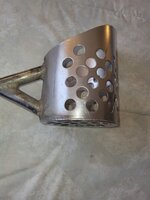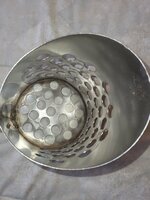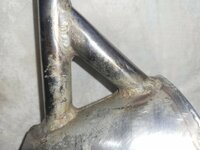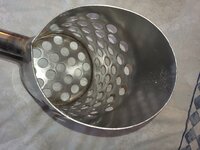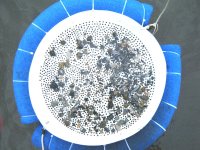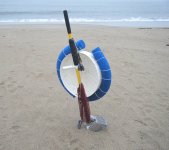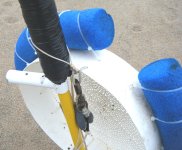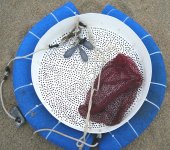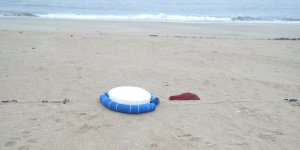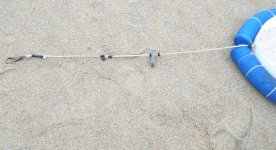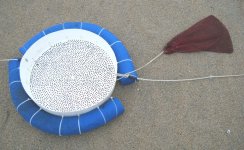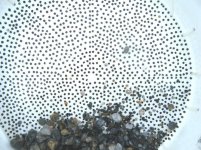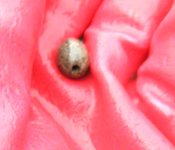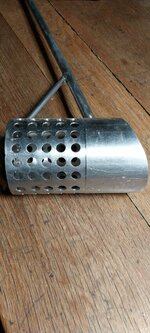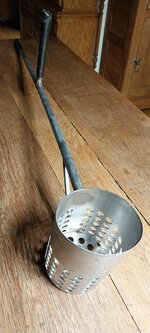Does anyone recognize this scoop design? I bought this one over 20 yrs ago and have used it in rocks mud clay and it is still.like new.It is 5 inches and I would like to buy a bigger one .it weights 3.5 lbs. The lady I bought it from had a shop near siesta key and her husband was a well known around the west coast of fla.He might of even made the scoops.They definitely hold up to some rough use.
You are using an out of date browser. It may not display this or other websites correctly.
You should upgrade or use an alternative browser.
You should upgrade or use an alternative browser.
5 in stainless scoop
- Thread starter C-COD
- Start date
Surf Master
Forum Supporter
That is a RTG scoop . they are still in business in Florida ! http://rtgstore.com/ They still make that model for dry sand hunting . The RTG scoops are a beginner scoop , as you get into wet sand & water , Stealth now out of business , Xtreme makes a nice scoop in 316 SS get a carbon fiber handle with it , you will have a nice scoop for years , happy hunting , Earl
Last edited:
CalReg
Forum Supporter
I have one that I bought 4 or 5 years ago. I use it when hunting dry sand at the beach. It's not very big, so I opt for one of the larger scoops (8 or 9 inches) when hunting the wet sand.
Last edited:
Thanks for the information. I will look into the extreme scoop. The RTG 5 INCH has a stainless long handle. It adds to the weight. It works well in the clay and the mud and getting through the small rocks.i could imagine what a 9 in full of mud and 4 0z piermid sinker would feel like trying to break it loose from the clay and mud.the bigger scoop would definitely be nice out in the water and a lot faster at retrieving targets.
metaladdict
Elite Member
there are many scoops available, I use a lower price one. It is a Stavr brand.
The Extreme scoop is a lot heavier than the scoop you pictured here...Thanks for the information. I will look into the extreme scoop. The RTG 5 INCH has a stainless long handle. It adds to the weight. It works well in the clay and the mud and getting through the small rocks.i could imagine what a 9 in full of mud and 4 0z piermid sinker would feel like trying to break it loose from the clay and mud.the bigger scoop would definitely be nice out in the water and a lot faster at retrieving targets.
Water hunting has been my preferred method for many years and for most of those years I used a floating sifter with no metal in its construct. This allows for using the detector to quickly determine if the target is in the sifter and allows a pin-pointer to locate the item easily instead of trying to recover it from a heavy scoop-load of sand and gravel!Thanks for the information. I will look into the extreme scoop. The RTG 5 INCH has a stainless long handle. It adds to the weight. It works well in the clay and the mud and getting through the small rocks.i could imagine what a 9 in full of mud and 4 0z piermid sinker would feel like trying to break it loose from the clay and mud.the bigger scoop would definitely be nice out in the water and a lot faster at retrieving targets.
The sifter I used can be found in my past threads along with the stainless scoops I have used over the years.
Good luck and happy hunting,

CJ
Last edited:
Not being nosey but what did you use for a sifter on the bottom? I was thinking about using pool noodles and a sheet of plexiglass with a bunch of holes drilled in it and held together with tie ties.Water hunting has been my preferred method for many years and for most of those years I used a floating sifter with no metal in its construct. This allows for using the detector to quickly determine if the target is in the sifter and allows a pin-pointer to locate the item easily instead of trying to recover it from a heavy scoop-load of sand and gravel!
The sifter I used can be found in my past threads along with the stainless scoops I have used over the years.
Good luck and happy hunting,
CJ
I used the bottom of a 55 gallon plastic drum with holes drilled just smaller than a dime and large foam swim noodles fastened with plastic slip ties. Works great!!Not being nosey but what did you use for a sifter on the bottom? I was thinking about using pool noodles and a sheet of plexiglass with a bunch of holes drilled in it and held together with tie ties.
CJ
PS from an old post------------Water hunting has been my preferred method for many years and for most of those years I used a floating sifter with no metal in its construct. This allows for using the detector to quickly determine if the target is in the sifter and allows a pin-pointer to locate the item easily instead of trying to recover it from a heavy scoop-load of sand and gravel!
The sifter I used can be found in my past threads along with the stainless scoops I have used over the years.
Good luck and happy hunting,
CJ
This AM at 8 I waded out into our calm local waters to see how much metal I could remove from the waters edge out into the water for the distance of a long coil swing. (I was in knee-deep water.)
Both my hunting partner Frank and I have worked this short stretch to death, but I know from experience that no matter how hard you work an area there are still pieces of metal there to be found.
I brought along my little Fuji to record how important my sifter is to me for finding small targets.
The first shot shows the small stones left after I washed out the excess, but the dark colored piece of metal blended in so well with the stones I couldn't find it.
Rather than waste a lot of time I ran the coil over the all plastic sifter and determined the target was there.
With my Vibra-Probe pin-pointer I located the small fishing-net weight and separated it from the stones as shown in the next shot.
Pic 3 is of the weight in my glove and 4 is of a curious Gull that was only 6' or so away at one point during this exercise.
The very next target was a .22 Caliber cartridge case (shown in my next post) that was also tough to find and easily can fall through my scoop holes, so I make it a habit of dumping the scoop into the sifter as quickly as possible just to avoid losing the targets.
GL&HH Friends,
CJ
Attachments
Last edited:
PS from an old post------------
This AM at 8 I waded out into our calm local waters to see how much metal I could remove from the waters edge out into the water for the distance of a long coil swing. (I was in knee-deep water.)
Both my hunting partner Frank and I have worked this short stretch to death, but I know from experience that no matter how hard you work an area there are still pieces of metal there to be found.
I brought along my little Fuji to record how important my sifter is to me for finding small targets.
The first shot shows the small stones left after I washed out the excess, but the dark colored piece of metal blended in so well with the stones I couldn't find it.
Rather than waste a lot of time I ran the coil over the all plastic sifter and determined the target was there.
With my Vibra-Probe pin-pointer I located the small fishing-net weight and separated it from the stones as shown in the next shot.
Pic 3 is of the weight in my glove and 4 is of a curious Gull that was only 6' or so away at one point during this exercise.
The very next target was a .22 Caliber cartridge case (shown in my next post) that was also tough to find and easily can fall through my scoop holes, so I make it a habit of dumping the scoop into the sifter as quickly as possible just to avoid losing the targets.
GL&HH Friends,
CJ
Attachments
Nice looking sifter. Thanks for sharing.I used the bottom of a 55 gallon plastic drum with holes drilled just smaller than a dime and large foam swim noodles fastened with plastic slip ties. Works great!!
CJ
hoser
Forum Supporter
Careful what you wish for. The way the weather is going you may have waterfront property before you know it.if we only had more water her in AZ
hoser
Forum Supporter


